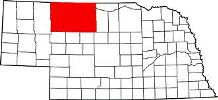Extension, Cooperative
Date of this Version
1944
Abstract
Pasture-Forage-Livestock
A special P. F. L. cooperators card was made up for the range area. Five hundred cards were mailed out and 105 returned with signatures. Of the eleven practices listed on the card, the cooperator was asked to check those in which he was interested and wished information on. Labor saving devices ranked first, cattle grub control-second, protein supplements-third, minerals-fourth, wintering cattle on early cut hay-fifth, and bangs disease control-sixth. The average number of practices per rancher was approximately five.
Noxious Weeds
Bindweed infestation is rather limited in the county. Five drums of Atlacide were shipped in to the county, but soil was too dry for application.
Crop Production
Seed test service was furnished 22 farmers. Pure seed of improved oats and barley was placed on 12 farms. Certified varieties of Cheyenne winter wheat was furnished 2 cooperators this fall. On the Kenneth Hall farm, 19 corn hybrids and 5 local open pollinated varieties were grown in a test plot. Due to the exceptionally late varieties were grown in a test plot. Due to the exceptionally late frost the hybrids showed up well. Many out yielded the local varieties by 4 to 10 bushels. A field day was held at the tie of harvest, 12 farmers took time off the visit the field. No sorghum plots were seeded this year as interest has waned since the seasons have become more normal. Three Minnesota grain smut treaters were made.
Livestock
Activities in livestock production have centered around management, disease prevention and control. with no active local veterinarian in the county, a large number of stockgrowers come to the county agent for information and advice. Thirty two such cases were taken care of. Bangs Disease and foot rot in cattle, erysipelas in hogs and various poultry diseases were the chief troubles. Survey cards returned by 112 ranchers show that on 54% are practicing calf-hood vaccination. The agent supervised a feeding test comparing various amounts of soybean oil meal with and without mineral as a supplement to prairie hay for wintering calves. Feeding one-half pound with 8% of steamed bone meal proved more profitable than one pound alone. Thirteen ranchers have called at the office to discuss protein supplements. Data from a dairy herd was summarized to determine the feed required to produce 100 pounds of milk and per pint of butterfat. For cows producing over 200 pounds of fat, it took 6.6 pounds of grain, 198 pounds of hay and 25.5 pounds of silage exclusive of pasture, to produce one pound of fat. Three cattle grub control demonstrations were given to 223 spectators.
Soil Conservation
In in the cultivated area of the county, strip cropping for benefit payments, under the A. A. A. is the only conservation practice of interest to farmers. Approximately 13% (18,709 acres) of the cultivated land is strip cropped. A series of seasons with more favorable moisture conditions has done much to compensate for the tendency toward over grazing in the range area. However, the educational program on range management has made ranchers more cautious. Deferred grazing was practiced on 350,918 acres of range land. Thirty six land owners planted a total of 36,200 Clarke-McNary trees, the majority of which were cedar.
Farm Labor
A shortage of labor prevailed throughout the year. Of the 94 workers placed on farms and ranches, less than 10% were handled by local volunteer labor representatives. Cards returned from 76 ranchers indicated a need for 235 hayhands. One hundred and sixty six persons called at the office personally during the year requesting help for various jobs. Very few transient laborers came into the county and only 12 Mexican Nationals were used. Six farm workers were referred to the irrigated section for potatoe and beet harvest. Seventeen were released for non-agricultural work. Time was taken to check 22 deferment cases.
Food Preservation
Food Preservation demonstrations were held in two communities with 32 persons attending. A sample survey was taken from rural and town families to get an estimate of the food preservation, within the county. The amount is as follows: 370,650 qts. of canned fruit; 376,100 qts. of vegetables; 57,970 qts. of meat; 2,810 gallons of vegetables bruined and 2800 pounds dried; 7,390 pounds of fruit and vegetables frozen; 288,960 pounds stored. The total meats cured and frozen amounted to 455,790.
Women's Club Work
The Study club, at Wood lake, reorganized and a new club was formed at Merriman. Three Project clubs failed to reorganize. Lack of interest in lessons and wartime emergencies were given as reasons. Seventy four members in 8 clubs are carrying on adult home demonstration work.
4-H club Work
Eight 4-H clubs were organized with a membership of 17 boys and 35 girls. completions were so few on last years "Pair for Victory" membership that no effort was made for enrollments this year. Four boys enrolled and one completed his project. Two community and one county achievement programs were held. The demonstration team competing at the State Fair was warded a red ribbon. Once club leader, Mrs. Clarence Kellogg, is eligible for a 5 year award medal.
Government Agencies
The U. S. D. A. County War Board has been furnished information on 29 deferment cases and 5 requests for discharge from the armed forces. The agent attended all meetings, of the Board. One county planning meeting F. S. A. was participated in. The agent served on the county bond committee and one special letter was mailed out, by him, to all parties engaged in agriculture. The American Legion sponsored the salvage drives.



Comments
Courtesy Cherry County (Nebraska) Extension Office